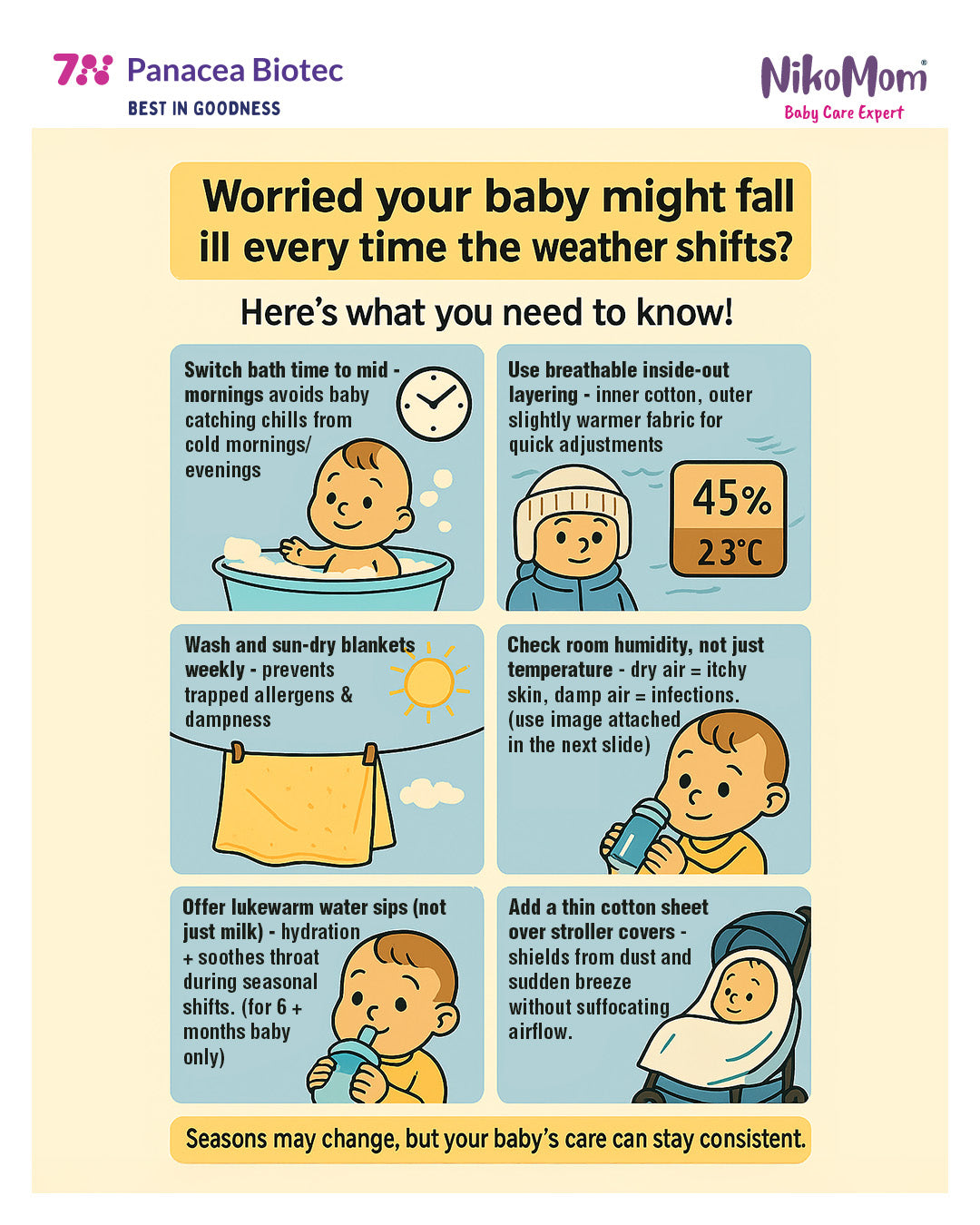Keeping Your Little One Comfortable Through Every Season
Share

At a Glance
Season changes are part of life, but for parents, they often bring fresh worries. Will your baby catch a cold with the sudden drop in temperature? Should you change their bath routine? Is the dry air causing that patch of itchy skin? In this blog, we’ll unpack these everyday concerns and share tried-and-tested tips to help you care for your baby as the weather transitions. Because while seasons may change, your love and care can stay steady.
“Worried your baby might catch a cold every time the weather shifts? Here’s what you need to know!”
As parents, we know how quickly babies pick up discomfort from their surroundings. A sudden cool breeze, humid air after a shower, or even dry winter winds can affect them more than it affects us adults. This is why seasonal transitions - summer to monsoon, or monsoon to winter, are a big deal in every Indian household with a baby.
We Understand Your Worries
It’s natural for mothers to feel anxious during seasonal shifts. You’re not just managing temperature changes - you’re also worried about:
- Colds and coughs triggered by fluctuating weather
- Dry, itchy skin in winter or after exposure to damp air
- Hydration challenges, especially when babies don’t always show thirst clearly
- Allergens and infections that creep in through blankets or damp clothes
If you’ve ever spent the night adjusting a blanket over your child or checking the fan speed, you’re not alone. These concerns are common and valid.
Practical Tips for Weather-Ready Baby Care
Here are some expert-backed, simple shifts you can make to keep your baby comfortable through seasonal transitions:
1. Switch Bath Time to Mid-Mornings
Avoid chilly mornings or cool evenings, which increase the chance of your baby catching a cold. A mid-morning bath works best - warm enough to soothe but not too hot to dry out the skin.
2. Master the Art of Breathable Layering
Indian weather is unpredictable, a warm afternoon can quickly turn into a cool evening. Dress your baby in inside-out layering:
- Soft cotton inners for breathability
- A slightly warmer, easy-to-remove outer layer
This way, you can adjust their clothing within seconds whenever it’s needed.
3. Check Room Humidity, Not Just Temperature
Parents often monitor room temperature but forget humidity. Here’s why it matters:
- Dry air (common in winters with heaters) → causes itchy skin, chapped lips
- Excess dampness (common in monsoon) → encourages mold and infections
A simple bowl of water near the bed or a room humidifier can make a big difference.
4. Weekly Wash & Sun-Dry Blankets
Sunlight is India’s most reliable disinfectant. Wash your baby’s blankets weekly and dry them in the sun. This prevents allergens, trapped moisture, and that musty smell that lingers in monsoon.
5. Hydration Beyond Milk (6+ months)
If your baby is over 6 months, offer lukewarm sips of water between feeds. It helps with hydration, keeps the throat moist, and is soothing during weather transitions.
6. Shield Without Stifling in Strollers
When stepping out, cover stroller canopies with a thin cotton sheet. This creates a breathable shield against dust, pollen, and sudden breezes, without suffocating airflow.
You’re Not Alone in This Journey
Remember, these seasonal ups and downs are a part of your baby’s natural growth environment. What matters is not eliminating every risk, but building resilience with smart, gentle care. At Nikomom, we are here to walk with you, offering trusted guidance and baby care solutions so that you can focus on what matters most: your baby’s happiness.
A Mom-to-Mom Insight
Seasons will always change, but your baby’s comfort doesn’t have to. With small, thoughtful tweaks - like adjusting bath times, layering clothes, and paying attention to room humidity, you can create a cozy, safe environment no matter what the weather brings.
Try one of these tips today and see the difference in your little one’s comfort. For more parent-friendly insights, explore more in our Blogs section.
